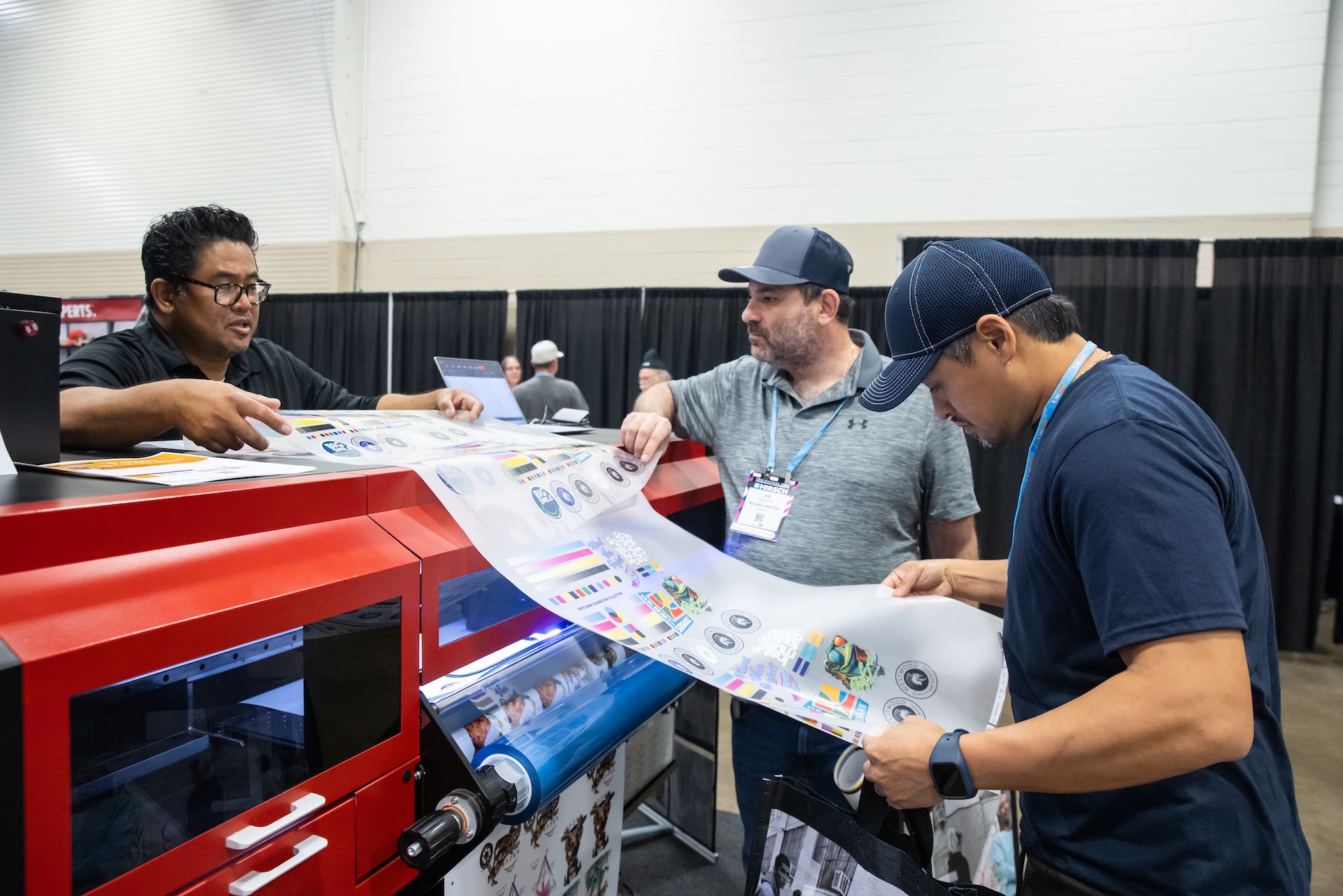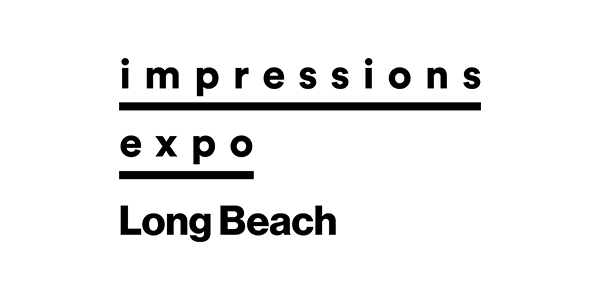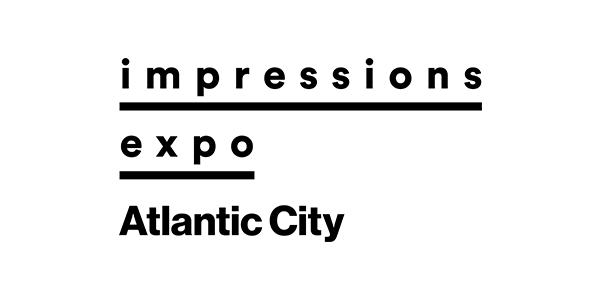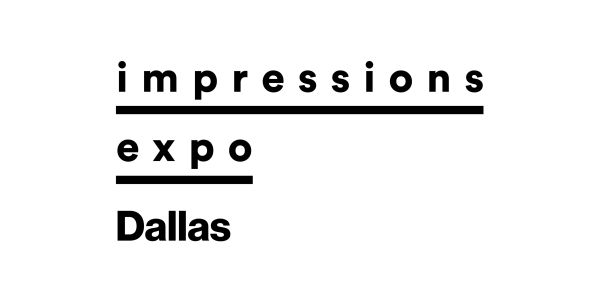The future is now for direct-to-film (DTF) printing and the decorated-apparel industry
Decorators of all kinds are adopting direct-to-film (DTF) as a means of improving their bottom line. In Part 1 of this two-part series, we look at the nuts-and-bolts of DTF and the question of large print orders. In Part 2 of this series we look at the advances now being made in the areas of DTF special effects and purchasing options/decisions.
I write these words in the wake of the 2024 Impressions Expo in Fort Worth, Texas, (which takes place in Dallas, Texas, in 2025) and the timing couldn’t be more appropriate. Why? Because of the absolute tidal wave of direct-to-transfer, or DTF, tech that was on display there.
Custom DTF providers, DTF machines large and small, education sessions on everything from DTF design to pricing and marketing, it seems DTF is everywhere these days.
DTF (Direct-to-Film) Technology is Now Well Established
And why not? As is the case with many cutting-edge technologies, DTF proved problematic at first. However, it didn’t take long for materials suppliers, equipment suppliers and the DTF community as a whole to get many, if not most, of the kinks worked out. The result is a decorating methodology as reliable as any other methodology out there.
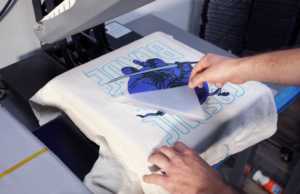
One of the great things about DTF decorating is the low barrier to entry. All you need is a quality heat press and you’re ready to go into business. Note how the transfer material on this Ninja Transfers’ print can be removed before having to wait for it to cool. Photo courtesy of Ninja Transfers
Not only that, but many of the limitations, as it were, of going with DTF have also become less of an issue as the DTF ink and systems manufacturers of world continue to hone their craft. Case in point: the growing automation of the process, from transfer creation to actual pressing, allowing DTF to increasingly nip at the heels of high-volume screen printing.
The growing number of custom DTF transfer providers out there also makes it incredibly easy to get started in this kind of decorating, thanks to a combination of increasingly sophisticated online design services and faster and faster delivery times. Get yourself a quality heat-press, create an account with a reputable custom DTF manufacturer, and you’re ready to go.
“DTF transfers have been a game changer for hundreds of thousands of businesses,” said Michael “Ninja Mike” Nemeroff, CEO of custom DTF provider Ninja Transfers, describing the technology’s continuing growth. “DTF has been the ultimate superpower for our industry and beyond, allowing businesses to customize almost any product, any material, any color, in any location. If a customer wants 10 different designs on 10 different products/materials and 10 different locations, it doesn’t matter.”
“As advancements in color accuracy emerge and some of the brightest minds in the industry focus on refining the process, enhancing both tactile feel and printing efficiency, DTF transfers are expected to capture an ever-larger share of the decoration market,” agreed Dave Conner of custom DTF provider STAHLS’ Transfer Express, whose company also manufacturers some of the industry’s most advanced heat presses.
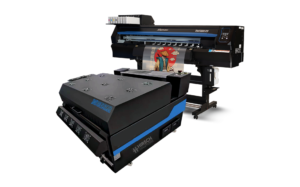
A higher-volume Mimaki press complete with shaker/heater as distributed by Hirsch. Photo courtesy of Hirsch Solutions
Along these same lines, Nate Sprowell, vice-president of custom DTF printing at 613 Originals emphasized the aforementioned low barriers to entry and continued innovation as key drivers of the technology’s success. “Before DTF, the industry often required hefty investments in equipment, materials and space, or hitting high order minimums to make production worthwhile. Now, anyone with a heat press and a creative vision can start small and grow profitably,” Sprowell said.
“As the landscape continues to evolve, DTF will find its way into other sectors and business models,” agreed Zac Biberstine, director of product management at M&R, a longtime force in the world of screen-printing that has recently made a serious splash in the DTF world as well with its new QUATRO Direct to Film Transfer Printing System. “The rise of direct-to-film may not have been predicted by everyone, but it is very clear now that DTF is here to stay.”
For his part, Marc Vila, director of marketing at ColDesi, a leading providing of DTF printers, ink, film and other supplies, said: “There are many large-scale screen print production facilities who have not yet adopted this technology. As their equipment ages, they will.”
How DTF Custom Apparel Decorating Is Done
In practice, DTF consists of a multi-step process whereby a full-color (CMYK) image is printed onto a sheet of specially formulated polyethylene terephthalate (PET) release film that is then applied using a standard heat press. In an important intermediate step, a powder adhesive is also sprinkled onto the design immediately after printing. This adhesive is then heat cured along with the ink making up the design to create an image that will adhere to the item being decorated, i.e., heat pressed.
Among the benefits of this approach are the fact that:
- The resulting transfer does not have to be heat-pressed right away, but can be stored pretty much indefinitely. This in turn provides an excellent means of managing inventory and avoiding waste, since you can easily decorate individual garments on demand, as opposed to having to screen-print a bunch of T-shirts in advance—shirts you may never sell.
- There are no screens to burn, nor do you need to worry about things like color separation or half-toning, as is the case with screen-printing. Download the design you plan on applying and a high-resolution, full-color image comes out the other end. DTF is great for reproducing photographs, for example, a heavy lift for screen printers, especially.
- Turnaround times couldn’t be faster. Download the desired design, print, apply the adhesive powder and press—that’s it. Again, because the transfers can be stored indefinitely, small or even individual orders can be processed on demand. Time-sensitive orders, in particular, become a piece of cake.
- In contrast to sublimation and direct-to-garment (DTG) decorating, DTF can be used on a wide range of fabric types, including cotton, blends, polyester, nylon and neoprene.
- There’s no need for any kind of pre-treatment, as is the case with DTG, and DTF works well with all fabric colors, including dark ones, unlike sublimation, which only works with very light colors or white.
- While there’s a learning curve, DTF apparel decoration is much easier to master than methods like screen printing or embroidery. There’s also no cutting or weeding to do, as is the case with heat-transfer vinyl.
“DTF shines when you’re working with small orders of one to 10 pieces or detailed designs that require full-color CMYK printing. It’s also incredibly easy to place and apply, thanks to the carrier film,” 613 Originals’ Sprowell said. “With DTF, you can print and store transfers, then apply them as needed…The same transfer can be applied to different fabrics, colors or even items like bags or hats without additional prep.”
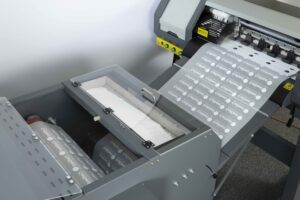
A closeup view of the shaker feature on the ColDesi DTF-24H4 printer. Photo courtesy of ColDesi
“DTF on hats and bags and jackets etc., this has been an absolute game changer,” agreed Ninja Transfers’ Nemeroff. He noted DTF also works well decorating harder-to-process spots, such as sleeves. “Pressing on sleeves is much easier than printing on sleeves in our experience. While we still screen print, it’s been a huge advantage we’ve had by pressing on sleeves especially when the design is more than one color, in a tough location, or a complicated design.”
“Direct-to film-has emerged as the go-to decorating solution for low- to medium-quantity orders, offering full-color, high-quality capabilities on a variety of fabrics with minimal setup and equipment,” STAHLS’ Conner said. “Screen printing, by contrast, involves significant costs associated with the press itself and the labor required for setup and operation. The process—setting up screens, inking them and registering the print—can take as much time as it would for an operator to complete 24 or more pieces on a heat press.”
If this all sounds too good to be true, well, there’s a reason why DTF has been taking off the way it has of late—because it’s a truly outstanding technology. That said, DTF poses its share of challenges as well. Again, though the issues at play are hardly insurmountable. The situation also remains a very dynamic one, given the technological advances that continue to be made throughout the industry.
DTF and the Challenge of Large Production Runs
Since its inception, decorators interested in DTF have had to bear in mind the number of garments they plan on decorating. If you’re looking at a production run of, say, a few dozen T-shirts, great. If, on the other hand, you’re looking at an order for hundreds or even thousands of shirts, the situation can become a very different one.
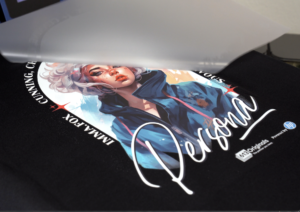
Vividly shaded and detailed designs are simplicity itself with a quality DTF print. Photo courtesy of 613 Originals
In terms of costs, for example, the nature of screen-printing is such that, once you’ve got your screen, or screens, burned and registered and the system up and running, the cost of decoration drops to mere pennies per shirt.
In addition, a fully automated, six-, eight-station press not only has to be seen to be believed but is capable of outputting literally hundreds of T-shirts per hour with little if any effort on the part of operators other than threading and then removing the shirts from the platen on which the actual printing takes place.
Compare this with the many steps required in DTF decorating, including printing the design, applying and curing the adhesive powder; cutting out the design from the sheet on which the design has been printed (assuming the design is one of many printed onto a single piece of film); positioning each shirt (or garment) individually; positioning and then placing the design to be heat-pressed; doing the actual pressing; removing the shirt or item you’ve pressed; and then, finally, peeling away the transfer material.
Again, all this may be no big deal if you’re processing a few dozen shirts. However, if you find yourself having to decorate garments by the hundreds or thousands, even, you’re talking a fair bit of effort.
High-volume Direct-to-Film Decorating Technologies
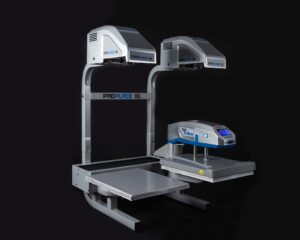
Today’s double-platen heat presses, like this Dual Air Fusion IQ, are expressly designed with throughput in mind. Note the system’s ProPlace IQ feature, which projects a pair of design images onto the two platens to ensure timely, accurate placement. Photo courtesy of STAHLS’
That said, when it comes to dealing with higher-volume orders, custom DTF suppliers and heat-press manufacturers are doing everything they can to make the heat-pressing process as easy as possible through the development of everything from products like STAHLS’ EasyRip technology (which eliminates the need to have to actually cut multiple DTF transfers apart) to automated, multi-platen presses and laser-placement systems (to ensure each and every transfer is positioned as it should) and transfers that can be peeled either hot or cold, thereby allowing an operator to remove the transfer film immediately after pressing, as opposed to having to wait for it to cool.
By way of example, pretty much every U.S.-based heat-press manufacturer these days includes one or more pneumatically operated presses in its product line; this in addition to the many manual presses out there equipped with “pop up” features that allow them to open up automatically after a set time, freeing an operator to step away if necessary during the actual pressing process.
Also available are fully automated shuttle-style presses that include a pair of separate platens allowing operators to remove and then re-thread a new shirt onto one of the platens while the other is engaged in pressing. Examples of the latter include the Geo Knight & Co., Inc. DK20SPT Digital Knight TWIN Air-Op Swing-Away Press; Insta Graphic Systems’ Dual Shuttle Heat Press; and the STAHLS’ Hotronix Dual Air Fusion IQ. The latter, in addition to foot-operated pneumatic operation and its twin platens includes the option of the newly introduced ProPlace IQ system, a positioning technology that projects a facsimile of the design being pressed directly onto a blank garment as it is being threaded onto the platen, in STAHLS’ words, “ensuring quick and precise alignment every time.”
“In the printing industry, decorators know how hard it can be to find experienced labor. Print placement is one of the things learned over time and can be one of the most time-consuming aspects of the heat printing process. The Hotronix ProPlace IQ solves this problem with accurate projection to reduce misprints and speed up production for any decorator,” said STAHLS’ Conner. “The ProPlace IQ allows employees or decorators of any experience level to be able to simply load the garment correctly, then place the logo to the light for perfect placement, every time.”
Equally exciting are the advances being made by ROQ and its distributor ROQ US. Long known for its top-of-the-line automated screen-printing systems, the company recently debuted a system it calls the ROQ IMPRESS, a fully automated, multi-station DTF heat press, complete with laser guides to help with transfer placement.
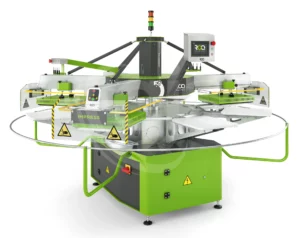
ROQ’s recently introduced fully automated IMPRESS system takes high-volume heat-press decoration to a whole new level. Photo courtesy of ROQ.US
Complementing the IMPRESS are the brand-new ROQ FEED, which automatically places each transfer and the ROQ PEEL, which as the name suggests, automatically removes each print’s transfer paper when the pressing it done. With these three systems in place, all that’s left to do manually is thread the blank garments onto a platen at one end and then remove the fully decorated garments from the other—a process that looks awfully similar to a fully automated screen-printing operation.
“If you factor in all the costs, time, risk and space required to run a screen printing shop, training printers, prep an order, ensure everything is perfect to reduce errors while printing, break down the screens, clean up, and assign job to the correct printer who can handle it and compare it to the simplicity of DTF pressing, you’ll quickly realize it’s so easy, your ‘professional’ 10-year-old nephew can do it,” Ninja Transfers’ Nemeroff said, putting the amount of time involved in DTF decorating in perspective.
“With innovations to the process, like Easy Peel Technology allowing you to peel hot, dual-platen heat presses or simply having more heat presses, you can handle any size order,” Nemeroff added. “Typically, customers are doing one-piece orders to 100-piece orders on the regular, but this has been increasing ever since DTF came out and will continue to rise in average quantity over time as everyone becomes more experienced with pressing DTF efficiently.”
ColDesi’s Vila agreed, emphasizing, the fact that it’s much easier to train someone to operate a digital printer than it is the many steps involved in screen printing. “The amount of square footage needed to operate a high-color automatic screen press is [also] significantly larger. As real estate prices increase, the cost per square foot of business operation becomes more important,” he added.
Bottom line: for those decorators convinced DTF only make sense for fulfilling smaller orders, think again. Plenty of companies are already pushing the envelope in terms of big numbers, and you may want to consider doing so as well. Per M&R’s Biberstine, “Whether they are testing the waters or diving in headfirst, its undeniable that our industry is adopting DTF as a core competency. You get to decide if you want to be part of it or just watch it happen.”
Ed Note: To see Part 2 of this two-part series, which focuses on DTF special effects and outsourcing DTF printing versus bringing the work inhouse, click here.
Updated 4/24/25

